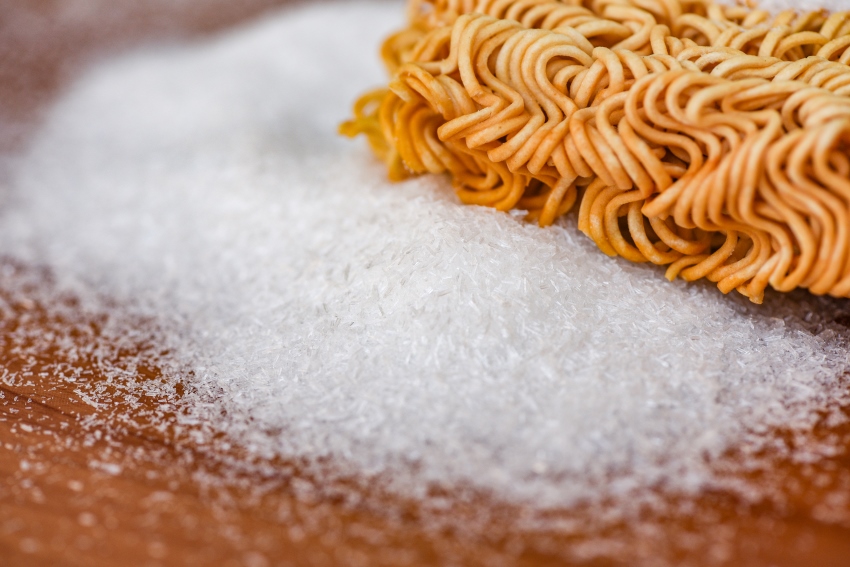In this day and age, it is almost impossible to do without ready meals completely. They are quick to prepare, convenient for on the go and offer a wide range of flavours. But what many consumers don't realise is that most of these ready meals contain a certain ingredient that is the subject of controversy: Monosodium glutamate, also known as E621.
This additive is often used to improve the flavour of food and can be found in a variety of products, from soups and sauces to crisps and frozen pizzas. But what exactly is E621? Is it harmful or even dangerous? And how can you deal with it if you don't want to give up ready meals completely? In this blog post, we will take a closer look at the topic of E621 and its use in food and give you helpful tips on how to use it in ready meals.
What is glutamate?
When it comes to glutamate, many people often think of added flavour enhancers in food. This is true in most cases, but not always. This is because there is also natural glutamate, as it is an amino acid that is a basic building block for proteins.
Glutamate can be found in practically all foods and is therefore an integral part of our daily diet. Our body can also produce glutamate itself. Different terms are often used synonymously. The term glutamate actually refers to the salt of glutamic acid.
In general, a distinction is made between the exogenous and endogenous origin of glutamate:
- Endogenous glutamate: The glutamate produced by the body. It has a variety of functions in the organism and plays an important role in the development of the nervous system and provides the intestines with energy.
- Exogenous glutamate: This refers to the substance ingested with food. This can be the industrially produced E621 or the naturally occurring glutamate in food.
Artificial flavour enhancers: What is E621?
Artificial flavour enhancers are usually the additive E621. It is chemically identical to the body's own glutamate. E621, often also known as monosodium glutamate (MSG), is one of the best-known flavour enhancers and is widely used both in industry and in private households. E621 is known for its umami flavour, which is often described as savoury or meaty.
The substance was first identified in 1908 by Japanese chemist Kikunae Ikeda, who investigated and isolated the characteristic flavour of seaweed broth. This is how the Japanese scientist discovered the flavour "umami", which means savoury. He found out that glutamate is responsible for this fifth flavour component is. In addition to the four other flavours salty, sour, sweet and bitter, humans are able to perceive this spicy impression through the taste buds.
E621 is currently produced synthetically by fermenting starchy or sugary plant substances such as maize, sugar cane or tapioca, similar to the production of yoghurt or wine.
E621 has been criticised as an artificial flavour enhancer. This is because E621 is used as a flavour enhancer in a wide range of products, including ready meals, seasoning mixes, snacks and much more. Its ability to enhance and intensify the umami flavour makes it a popular additive in the catering industry. E621 is often even used together with other flavour enhancers such as inosinate or guanylate to achieve an even stronger flavour.
E621 is authorised throughout the EU as an additive and may be used in foods up to ten grams per kilogram to make them spicier and tastier.
In its original and natural form, glutamate is found in foods such as:
- Tomatoes
- Cheese
- Eggs
- Poultry
- Pulses
- Soya
In addition to natural glutamate, highly processed foods also contain artificially added glutamate.
Glutamate is often found as additive E621 in:
- Ready meals
- Frozen products
- Tinned food
- Soups
- Spice mixtures
- Salad and seasoning sauces
- Chips
E621 and its effect on health

The "Chinese restaurant syndrome"
The so-called "Chinese restaurant syndrome" describes a series of symptoms that are said to occur after eating Chinese food and are often attributed to the monosodium glutamate content of the food. These include headaches, flushing (reddening of the face) and nausea. The Ärzte Zeitung writes that a US doctor of Chinese origin first described the syndrome in 1968 - he regularly complained of various symptoms after visiting Chinese restaurants.
Since then, it has been suspected that there is a connection with the frequent use of glutamate flavour enhancers in Chinese dishes. Despite the widespread assumption, scientific studies have not yet been able to prove a clear link between the consumption of E621 and these symptoms.
Is E621 harmful to health?
Endogenous glutamate, which occurs naturally in our body, plays an important role as a neurotransmitter or messenger substance between nerve cells. It is involved in pain transmission, body growth, weight regulation, appetite control and memory. If the glutamate level rises too high, brain cells can die.
It has therefore been investigated for some time whether glutamate can trigger diseases such as Alzheimer's, multiple sclerosis and Parkinson's, which lead to a progressive loss of nerve cells. Based on the current state of research, however, it is unlikely that the glutamate ingested with food will pass the so-called blood-brain barrier, even if the food is rich in flavour enhancers. It therefore does not reach the brain at all.
However, a link between artificial flavour enhancers and obesity is currently considered very likely. In a US study, researchers found that people who consumed a lot of glutamate were more likely to be overweight. It is assumed that E621 disrupts the hormonal balance and influences the feeling of hunger. This triggers a signal in the brain to eat more. This can lead to disturbed natural eating behaviour, as more food is consumed than the body actually needs. However, this is not referred to as "addiction". Natural flavour enhancers in fresh products are therefore considered the better choice.
Good to know: Glutamate cannot be completely avoided, as it is present in many foods anyway and our body produces it itself. Nevertheless, for the reasons mentioned above, we are warned against consuming too much glutamate. However, it should also be noted that none of the above theories have been conclusively proven.
At present, neither the WHO nor the German Nutrition Society consider glutamate to be harmful to health. Provided that it is consumed as part of a healthy, balanced diet.
Good to know: Due to the bad reputation of glutamate, many manufacturers use other terms to conceal the additive. A particularly conspicuous reference to flavour enhancers is the phrase "without flavour-enhancing additives" or "without glutamate additive". Instead, flavour-enhancing ingredients such as "yeast extract", "seasoning" or "tomato serum" are included. A particularly cunning declaration of glutamate is simply: "flavouring".
Digression: What is the difference between yeast extract and E621?
Have you ever eaten real, fresh yeast? It hardly tastes spicy at all. Yeast extract, on the other hand, has a strong, spicy flavour. This is also due to the fact that the natural amino acid glutamic acid, i.e. the glutamate mentioned above, which is responsible for the umami flavour, is only released when the yeast is extracted.
Yeast extract is obtained from baker's or brewer's yeast. Yeast extract is therefore the cell sap of the yeast, which is also available to buy as a brownish paste or yellowish powder. In Australia and New Zealand, yeast extract is often spread on bread as Vegemite, in England as Marmite.
Yeast extract contains around five per cent glutamate. Yeast extract also acts as a flavour enhancer, but unlike glutamate, it does not have to be labelled as such. While industrially produced glutamate is an isolated pure substance, yeast extract also contains amino acids, proteins, vitamins, minerals and salt in addition to glutamate. For this reason, yeast extract does not contain an E number.
The better choice: focus on naturalness
In general, artificial flavour enhancers should be used with caution for one reason in particular: they alter our natural sense of taste and therefore influence our appetite and eating behaviour. This particularly affects people whose diet consists mainly of ready meals and highly processed foods. These foods in particular often contain a large number of additives such as E621 and sugar, which are unnecessary for our body and its health and can also be harmful in large quantities.
It is therefore recommended to cook predominantly fresh and to favour home-made dishes over the popular frozen pizza, 5-minute terrines and the like. This not only promotes your well-being, but also your health.
Don't fancy doing without ready meals?
And you don't need to. Because we know that sometimes things have to be quick and you don't have the time or inclination to cook. But it should still be healthy.
That's why we develop wholesome, filling and healthy meals. They can be prepared in just 6 minutes. No additives, no flavour enhancers such as E621 and no industrial sugar. Our soups, stews and other ready meals only contain what belongs in them. Without any hide-and-seek.
Discover our delicious ready meals without compromise: Healthy organic ready meals (bleibwacker.com)



Sources: ÄrzteZeitung, AOK, Utopia, Stiftung Warentest
Photo E621: Adobe Stock, BigC Studio, #430330366
Photo Chinese food: Adobe Stock, Lukas Gojda, #264983638





The African bean stew is amazing. I could eat it every day. Wacker products are great.
I've been buying these for years. I eat differently from time to time. But I regularly do alkaline fasting in the Allgäu.
Now I've done the 5-day alkaline fasting programme at home. It was really good, no work, no annoying shopping.
I feel very well afterwards and still eat as alkaline as possible with the Wacker products.
Dear Elisabeth,
We are very happy to hear that! Thank you so much for your great feedback 🙂
Kind regards
Maren